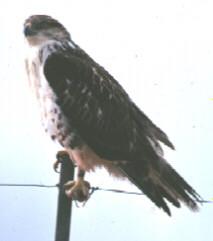Ferruginous Hawk (Buteo regalis)

TPWD ©
- Description
- The ferruginous hawk is the largest hawk in North America. With its puffed chest and stern eyes, it looks every bit like the classic hunter it is. As the name suggests, the adult is brown above with rusty streaks and white below. In flight, they look very similar to the red-tailed hawk. The telltale difference is that the ferruginous hawk's tail is white, while that of the red-tailed is a reddish-brown color. Rusty leggings form a noticeable 'V' against the whitish underparts.
- Life History
Rodents, cottontails and jackrabbits are the main fare of the ferruginous hawk, but they also will eat bats, bullsnakes, lizards and meadowlarks. They tend to hunt in the early morning and late afternoon hours.
This hawk prefers to nest in tall trees, but they are hardly limited to them. Cliffs and pinnacles are also likely sites for their nests of sticks, twigs and bones. The nests often are reused year after year so they usually are quite large with debris accumulation.
Both the male and the female participate in the nest building, followed by incubation of the three or four bluish or white eggs that are blotched with brown. The downy young hatch between February and July after approximately 28 days of incubation. They subsequently leave the nest some 44 to 48 days later.
- Habitat
- This hawk primarily is found on grassy prairies, dry mesas and habitats that support many rodents and rabbits. They are becoming rare throughout the United States and in Texas. Many are shot while perched along roadsides. Widespread control of prairie dogs, a vital source of food, also may lead to declines in ferruginous hawks. The federal government is awaiting additional information on them before deciding if they should be given federal status as an endangered or threatened species. ferruginous hawks range over much of the western half of the United States.
- Distribution
- Ferruginous hawks range over much of the western half of theUnited States. Historically they bred in Texas, but this is not the case today. Currently, the area that is most likely to support a nesting pair is in the far reaches of the northwestern Panhandle. They winter throughout Texas, but primarily in the western Panhandle.
- Other
- The federal government is awaiting additional information on them before deciding if they should be given federal status as an endangered or threatened species.